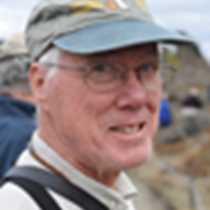Krossfjord, Spitsbergen
In 1596, the Dutch navigator Willem Barentz was searching for a sea route to open trade with the fur-rich lands of northwestern Russia. His previous two attempts had been foiled when he found the sea blocked by ice. This time his vessel followed a band of foggy, ice-free water that led the travelers northward. When the fog lifted, they spotted previously unknown land in the far north. They named it Spitsbergen, for the sharp peaks the reached skyward. They followed the coast of the new land back to the south, entering the major bays and inlets that they encountered. Alas, the new land was not Russia. There were no people with whom to trade, no furs to be gained, so their discovery was of little value. The ship was beset by ice and the travelers were forced to build a cabin and over-winter on Novaya Zemlya. Barentz died at the end of that winter, and the others returned over land.
Today we followed Barentz' route to the north, from Longyearbyen where our journey began, along the west coast of Spitsbergen. In the morning, we entered Kongsfjord ("King's Fjord"), and its northwestern arm, Krossfjord ("Cross Fjord"). At its head, we viewed the immense Lillehookbreen Glacier, bringing ice from the mountains above to the sea. We marveled at the ice in its blue splendor. The water teamed with seabirds, attesting to the rich productivity of the cold water. We landed near the 14th of July Glacier. The sky was filled with birds — little auks or dovekies, thick-billed murres, kittiwakes, and glaucous gulls — that nest on the cliffs above. With each trip to bring food to their young, the birds transport nutrients from sea to land, and so the tundra below the cliffs is richly fertilized. Tundra flowers bloom in profusion here, although barely sticking up above the rich moss layer. Barnacle and pink-footed geese graze on the luxuriant growth, accompanied by their new gosling. A group of Svalbard reindeer passed by on the slope above us, each animal molting from its winter coat of fur and sporting a new growth of antlers. The reindeer must take advantage of the short Arctic summer to breed and deposit the thick layer of fat that must carry them through the long, cold winter to come.
The calm water of the protected fjord offered perfect conditions for exploration by kayaks, and many took advantage of the opportunity (for opportunism is a trait of visitors and resident wildlife as well). Entering and launching the yellow kayaks from the ship, we could paddle at will among chunks of blue and white ice that have calved from the face of the glacier to complete their journey from land to sea. We can compare the present position of the face of the glacier to charts made in the late 19th and early 20th centuries on the four voyages of Albert I Grimaldi, Prince of Monaco and pioneer of the science of oceanography. From these, there can be no doubt that retreat of Spitsbergen's glaciers has accelerated in recent decades.




